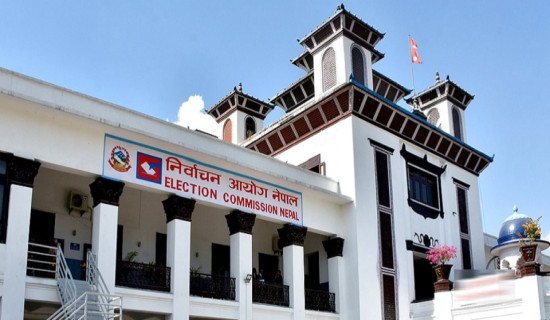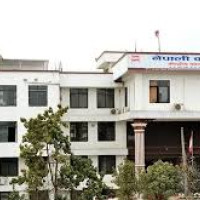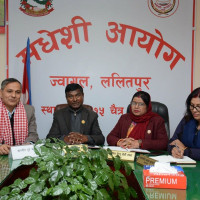- Thursday, 8 January 2026
Nepal Army proposes to revive Hetauda Textile at Rs. 1.93 bn
Kathmandu, Feb.1: The Nepal Army (NA) has said that the Hetauda Textile Factory (HTF) could be revived with a cost of Rs. 1.93 billion, and 2.6 million metres of textile could be produced within the next three years.
In a meeting with Prime Minister, Pushpa Kamal Dahal ‘Prachanda’ at the latter's office in Singha Durbar on Wednesday, the NA briefed PM Prachanda about the findings of the feasibility study conducted by it and said that the reoperation of the industry established in 1975 with Chinese technical assistance was possible.
It also said that the annual operation cost of the mill would be Rs. 780 million and it will reach at the break-even point nine years from the commencement of operation.
The government has pushed forward the agenda of reviving the HTF which has been in the discussion for the last one decade or so. The NA has conducted the feasibility study for the reoperation of the factory as per the provisions announced in the Policy and Programmes of the government for the current Fiscal Year 2023/24.
The industry had a capacity to produce approximately 36,000 metres of cloth per day. It ceased production of textiles in 2,000 after running at a loss for many years. King Gyanendra’s government had decided to permanently shut the mill in 2003 and it has already been liquidated and merged into the Industry District Management Limited.
Deputy Prime Minister and Minister of Defense Purna Bahadur Khadka, DPM and Home Minister, Narayan Kaji Shrestha, Finance Minister Dr. Prakash Sharan Mahat, Industry Minister, Ramesh Rijal, Vice-Chairman of the National Planning Commission, Dr. Min Bahadur Shrestha, Chief Secretary Dr. Baikuntha Aryal, Army Chief Prabhu Ram Sharma and high government and army officials were present at the meeting.
Poor marketing, overstaffing ruined the mill
According to the PMO, the study report of the NA has concluded that the factory was shut down due to its inability in market management, lack of technological modernisation, economic burden created by overstaffing and lack of managerial capacity to run an industry of that scale.
It said that the factory could be brought back into operation with the maintenance of some structures and machines, and the budget of the Nepal Army's military welfare fund was sufficient to manage such work. Likewise, most of the raw materials needed for this industry are available within Nepal and the market could be assured as there is a high demand of clothes for the army, security agencies and government employees.
The report has fixed the needs and rationales of the reoperation of the factory. According to it, the revival will reinstall the industrial prestige of the past, contribute to the industrial sector
development and Gross Domestic Product of the country, send positive message to the world market, substitute imports and enhance self-reliance and check youth flight with the creation of employment within the country.
2.6 million metres cloth in 3 years
The NA’s study task force has also proposed the modality of the industry’s reoperation which said that it would take three years if the government makes a policy decision to hand over the factory to the Army in the current FY and works like preparation of the Detailed Project Report, selection of new machinery and procurement would be completed for the estimated production of 2.6 million metre of cloth.
Test production of cloth could begin this year, the NA said and added that it could also initiate the feasibility study for the revival of Butwal Spinning Mill.
The task force has also proposed policy and legal assistance from the Government of Nepal to revive the industry and sought support of the latter in policy and legal process of the mill’s revival, clearing its remaining liability and handing it over to the NA, and using the cloth produced by the factory in government agencies.
Speaking on the occasion, Prime Minister Prachanda said that a decision would be made by the Cabinet about reviving the factory. However, he maintained that he would like to discuss the matter at the political level and conduct a study by a government team as well.
According to him, the privatisation of the country’s industries had caused a decrease in production as well as employment opportunities.
Revival was possible in 2016 Earlier, in October 2016, the government had decided to run the HTF in collaboration with the Nepali Army, Nepal Police and Armed Police Force.
Then Minister for Industry lateNabindra Raj Joshi, had a plan that the three security agencies would run, along with private sector representatives on board, the textile mill in the first phase and produce uniforms for their personnel and school students.
The revival cost of the factory then was estimated at Rs. 300 million and the government study found that about 40 per cent machines and equipment were in condition.
A task force led by NPC Member Dr. Pushkar Bajracharya was also formed in 2016 to look into the possibility of the revival of the industry. The task force had concluded that there was a possibility of running the mill in a profitable way.












-original-thumb.jpg)



